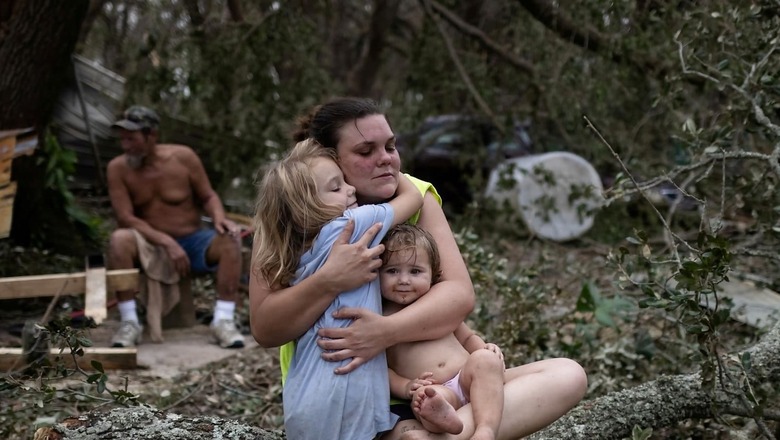
views
At least nine deaths were reported in New York City and New Jersey as relentless rain from the remnants of Hurricane Ida sent the New York City area into a state of emergency early Thursday and the storm carried into New England with threats of more tornadoes.
Police in New York City reported seven deaths, including a 50-year-old man, a 48-year-old woman and a 2-year-old boy who were found unconscious and unresponsive inside a home. They were pronounced dead at the scene, police said. One death was reported in New Jersey.
New Yorks FDR Drive, a major artery on the east side of Manhattan, and the Bronx River Parkway were under water by late Wednesday evening. Subway stations and tracks became so flooded that the Metropolitan Transportation Authority suspended all service. Videos posted online showed subway riders standing on seats in cars filled with water.
Other videos showed vehicles submerged up to their windows on major roadways in and around the city and garbage bobbing down the streets.
Emergency in New York City
We’re enduring a historic weather event tonight with record-breaking rain across the city, brutal flooding and dangerous conditions on our roads, New York Mayor Bill de Blasio said while declaring a state of emergency in New York City late Wednesday.
Governor Kathy Hochul also declared a state of emergency for New York state.
The National Weather Service office in New York declared its first-ever set of flash flood emergencies in the region Wednesday night, an alert level that is reserved for exceedingly rare situations when a severe threat to human life and catastrophic damage from a flash flood is happening or will happen soon.
Rain and rubble
The National Weather Service recorded 3.15 inches of rain in New Yorks Central Park in one hour Wednesday night, far surpassing the 1.94 inches that fell in one hour during Tropical Storm Henri on the night of Aug. 21, which was believed at the time to be the most ever recorded in the park.
Earlier Wednesday, the storm blew through the mid-Atlantic states with at least two tornadoes, heavy winds and drenching rains that collapsed the roof of a U.S. Postal Service building in New Jersey and threatened to overrun a dam in Pennsylvania.
Social media posts showed homes reduced to rubble in a southern New Jersey county just outside Philadelphia, not far from where the National Weather Service confirmed a tornado Wednesday evening. Authorities did not have any immediate information on injuries.
The roof collapsed at the Postal Service building in Kearny, New Jersey, with people inside, police Sgt. Chris Levchak said. Rescue crews were on scene into the night, with no immediate word on the number of people or severity of injuries.
Timeline and threat
Ida slammed into the southern United States on Sunday. It has since weakened but has caused severe flooding and tornadoes in Pennsylvania, New Jersey and Maryland were in Annapolis, 30 miles (50 kilometres) from the US capital, a tornado ripped up trees and toppled electricity poles.
The NWS warned the threat of tornadoes would linger through Wednesday night, with tornado watches in effect in parts of southern Connecticut, northern New Jersey, and southern New York.
Ida is expected to continue steaming north and bring heavy rainfall on Thursday to New England, which was hit by a rare tropical storm in late August.
US President Joe Biden is due to travel Friday to Louisiana, where Ida destroyed buildings and left more than a million homes without power.
Echoes of hurricanes past
Ida came ashore 16 years after Katrina and a year after Hurricane Laura wrecked the southwest region in the US Louisiana, leaving communities without power for weeks. Even as Ida was bearing down on New Orleans, marks of Laura’s devastation remained evident in blue-tarped roofs, damaged homes and boarded-up businesses that still dot the region.
Laura, which then was the most powerful storm to impact Louisiana since before the Civil War, struck the southwestern parishes on Aug. 27, 2020, as a fierce Category 4 storm. Less than two months later, Hurricane Delta swept into the same area as a Category 2. Historic flooding followed in May.
Cascading failures
Just as the deep freeze in Texas caused extensive suffering and death from cold, Ida will likely cause extreme suffering from excessive heat, experts have warned. The storm also was affecting water and sewer service, cell phone service and even 911 service.
In New Orleans, water and sewer officials said they lost all Entergy power, but teams were working quickly to make up for this with self-generated power sources, as well as backup generators located at drainage pumping stations.
Hurricanes are common in the southern United States, but scientists have warned of a rise in cyclone activity as the ocean surface warms due to climate change, posing an increasing threat to the world’s coastal communities.
(With agency inputs)
Read all the Latest News, Breaking News and Assembly Elections Live Updates here.




















Comments
0 comment